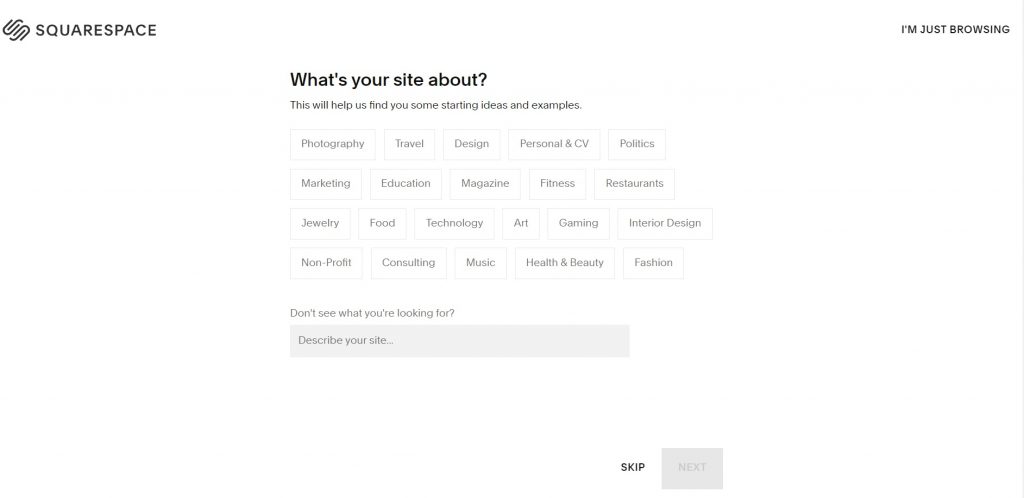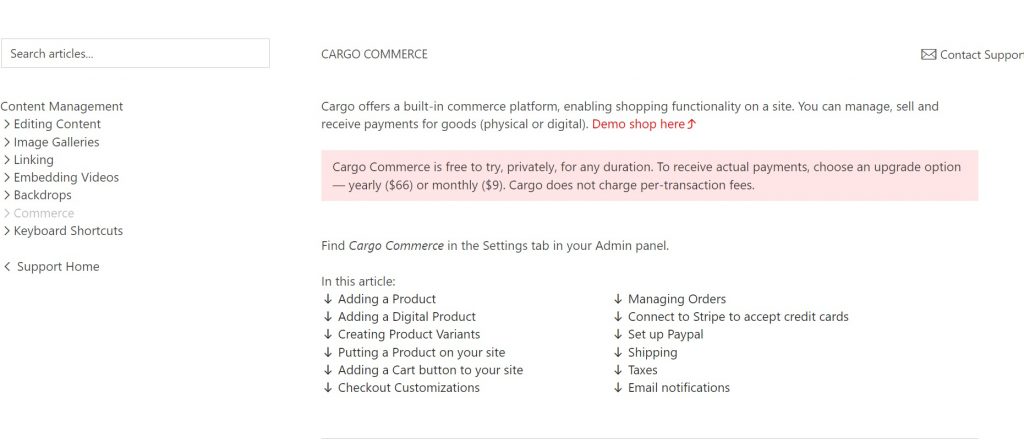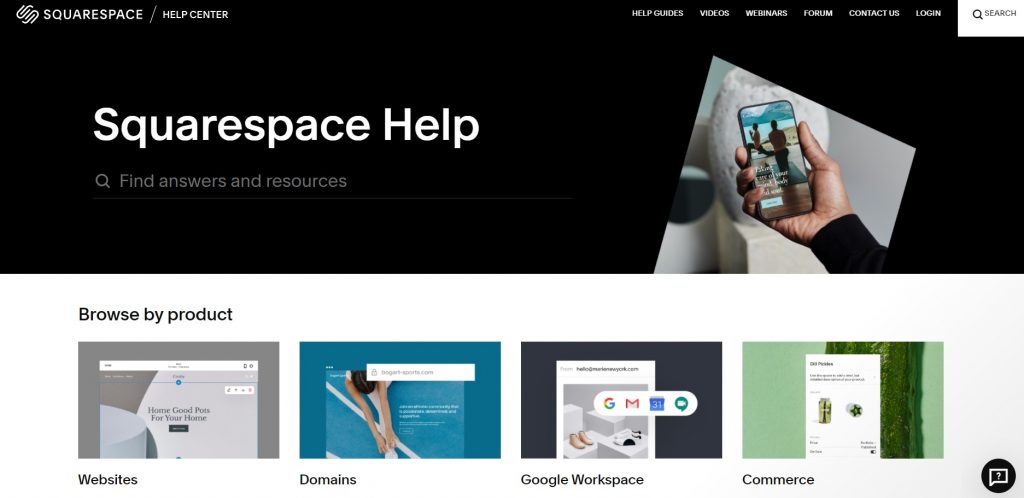In today’s review, I want to compare Cargo Collective and Squarespace. These website builders have a lot of features in common but differ in the way of their implementation.
For example, Cargo is focused on the visual aspect of web projects and offers a bunch of tools to customize fonts, styles, shapes, various blocks, etc.
In turn, Squarespace is a SaaS and web hosting platform that provides users with powerful e-Commerce features. Using Squarespace, you can create a full-fledged web store, set up taxes and discounts, use affiliate programs, and many more.
Today, I’ll guide you through the functionality of both services, show their customization options, describe the troubleshooting ways, and many more.
But before we dive deeper into the topic, I’d like you to check out the related articles that help you fill in the gaps and expand your knowledge about website builders.
Squarespace description:
Squarespace Review & Pricing [2021]
Best Squarespace templates for podcasting
How to back up a Squarespace website
Hot to add AdSense to Squarespace
How to add favicon to Squarespace
How to embed PDF into Squarespace
Methods to add a responsive table to Squarespace site
Squarespace comparisons:
Comparison
User experience and templates customizing
Cargo Collective
Starting using Cargo Collective is easy. You just need to register, name your website, and select from the offered templates. Currently, you may pick one of the 75 fully responsive and highly customizable layouts.

After that, you’ll be transferred to the dashboard with a control panel located on the right side.
Let’s see what the Cargo Collective’s control panel contains.
| Design | Here you can do the following: – change template width and padding by moving the slider; – edit a background picture; – add columns, blocks; – inbuild custom CSS or HTML code; – customize colors and fonts. The platform allows you to try a hand-picked set of fonts (some of them are open source) that were designed by Dinamo and Type Network. |
| Content | Here, you can work with media files, choose headers and footers, etc. |
| Commerce | This option allows you to: – add payment options; – set up shipping costs; – edit taxes rates; – customize checkout page, etc. |
| Settings | This menu gives you access to: – website settings (name of the site, favicon, URL, passwords, custom domain); – account settings (payment methods, DNS manager, login and email, etc.); – social sharing; – electronic commerce (that will be described in detail below). |
Also, you can switch between desktop and mobile page preview at any time during website creation.
Squarespace
Unlike its competitor, Squarespace requires you to answer a few questions before you can start. This survey can help the system to learn more about:
- Your goals. It can be simply showcasing your art project or building a webstore.
- Business industry. The platform allows you to choose from more than 20 options (technology, consulting, marketing, design, etc.). If you can’t find your category on the list, you may describe it on your own.
- Your experience. You’re offered to choose between “inspiration”, “running an already existing business”, etc.

When the survey is completed, you can look at layouts. As I’ve said before, they’re offered according to your survey answers. Of course, you can browse other layouts if necessary. All templates are available for preview before you start customizing them.
To begin with template customization, you need to go to the dashboard located in the working area. Compared to Cargo Collective, Squarespace’s control panel contains more buttons that can be confusing for inexperienced users. But it isn’t a serious problem if using Squarespace tutorials.
Now, let’s take a closer look at Squarespace’s control panel and what it contains.
| Design | It allows you to: – work with media files; – add columns and rows; c – change a background image; – edit spacing, colors, fonts, etc.; – change fonts and spacings; – inject custom code, and so on. |
| Pages | Using this option, it’s possible to:add or delete different types of pages; inbuild links to external web resources, etc. |
| Marketing | Using Squarespace’s marketing tool, you can do the following: – promote your project on social networks; – run email campaigns to collect leads; – create an advertisement for your web resource, and many more. |
| e-Commerce | As it was mentioned above, the platform has powerful e-Commerce features that allow you to: – create web stores and sell almost any type of products or services; – control financial gateways; – manage shipping and delivery; – create an affiliate network, and many more. |
| Profiles | It allows you to check the data about co-users, subscribers, etc. |
| Analytics | Using Squarespace’s analytics feature, you can explore the following: – your customers’ behavior; – the volume of sales (total and per product); – website traffic, and many more. |
| Settings | This option allows you to: – work with domains; – add or delete extensions; – build member areas, etc. |
If you’re versatile in coding, Squarespace has a resource called “Developers platform”, where you can get access to the template files and customize them according to your purposes.
E-commerce
Cargo Collective
The platform doesn’t have the advanced electronic commerce functionality as Squarespace does. At the same time, Cargo Collective allows you to create and run a web store.

Keep in mind that you can receive onsite payments only if you get a “Commerce” plan.
After creating a website on Cargo Collective, you need to go to the “Commerce” menu, where you can choose the type of product you want to sell and click on “Add new”. If you’re going to ship products, it’s important to set up the weight and dimension parameters.
If you sell digital products, the setting up process is even easier: just select the price for your product and add a link for downloading.
In case you sell different types of the same product, you may add item variants with their price, size, weight, etc.
To add an item to your web page, place the cursor in the location where you want to add a product and click on the “Add to cart” icon in the formatting toolbar. Then, you’ll see a menu that allows you to choose item variants, set up prices, and connect the “Add to cart” button.
After your customers make a purchase, it goes to the “Order” tab. There, the website owner can manage shipping details, check a print-ready packing list (it’s generated automatically), control refunds, and many more.
Currently, Cargo Collective supports PayPal, Stripe, and accepts any type of credit or debit card.
During tax adjustment, the platform recommends working with a tax adviser and using special guides for European and US sellers.
Also, your customers will receive email notifications about key actions like order approval and shipment. If your customers requested a refund, they would also receive a confirmation email.
Squarespace
As I’ve said, this platform is more advanced in terms of electronic commerce compared to its competitor. The main steps of adding products, setting up prices, editing taxes, and shipment details aren’t very different from Cargo Collective. That’s why I’ll focus on what differs only.
First of all, Squarespace offers its users to purchase gift cards. These cards have unique codes, which can be sent to recipients or used by customers themselves. The platform also allows you to download a mobile application with full-fledged eCommerce features (you can use it to activate push notifications; fulfill and print orders; add products and many more).
Compared to Cargo Collective, Squarespace also offers to sell products in person by creating a Squarespace point of sale. To do it, you need to be a Squarespace user, get a Square reader to accept payments, and connect your bank account to Squarespace. Nonetheless, there are some restrictions:
- the Squarespace’s point of sale is available on the US territory only;
- it isn’t available for the “Personal” plan subscribers.
If some products aren’t in stock, the platform allows you to accept pre-orders.
Analytic and performance
Cargo Collective
Unlike its competitor, this service doesn’t have inbuilt tools to analyze customers’ behavior, top-selling products, source of traffic, and so on. At the same time, you can add third-party integrations for that purpose. And the most widely used among them is Google Analytics. To do it, you need to log in to Google Analytics and do a few simple steps to generate your personal tracking code. After that, go to the admin section and find your tracking code in the “Tracking info” menu. Then, you need to go to the Cargo Collective’s admin panel, click on the “Design” button, and choose “Custom HTML”. After that, you can see a code block to add your tracking code. In case you have a multipage website, a tracking code will work for all of them.
Usually, it takes from 24 to 72 hours for Google Analytics to start recording the activity on your web resource.
Using Google Analytics, you may track trends and find patterns of your visitors’ interaction with your website. Below, I’ve listed the most important metrics:
- the number of unique visitors;
- the number of specific page visitors;
- the duration of each session;
- the average number of pages, which are visited per session, etc.
Squarespace
The service comes with inbuilt analytic tools. Plus, you can also add Google Analytics to your website without a need to inbuild a script code (it’s an embedded integration). Since Google Analytics has been already described above, I’ll focus only on Squarespace’s embedded analytical options that help:
- measure your audience’s engagement;
- learn about your traffic patterns and understand the opportunities for expanding your business;
- detect geography of your visitors;
- check abandoned carts;
- identify top-selling products;
- calculate the revenue (total, per product), etc.
Pricing plans
Cargo Collective
Compared to Squarespace, Cargo Collective has only 2 pricing plans.
| Standard plan | Commerce plan | |
| Cost | It costs $99 if you purchase it on an annual basis. If you buy a monthly subscription, it costs you $13. Standard plan subscribers can use all the offered features for customization, which were described above. However, they can’t use the e-commerce options. | In this case, you need to pay an extra $66 per year or $9 per month depending on a yearly or monthly subscription. This plan has the same set of features as the “Standard” plan does. Additionally, you can use commerce features. The platform doesn’t imply transaction fees that I personally take as a serious advantage. |
| The available storage | only 100MB is available | no restrictions |
| The available number of co-users | 5 | no restrictions |
| The number of web projects you may build | 12 | no restrictions |
| The available number of pages you can create | 3 | no restrictions |
It’s worth noting that you can build a website even without purchasing the “Standard” or “Commerce” plans. But in this case, you won’t be able to publish them.
Squarespace
Unlike its competitor, Squarespace comes with 4 pricing plans, which provide users with different sets of features.
Let’s take a look at them.
| Features | Personal plan | Business plan | Basic Commerce plan | Advanced Commerce plan |
| Costs | It’ll cost you $16 or $12 depending on a monthly or yearly subscription. | It’ll cost you $26 or $18 depending on a monthly or yearly subscription. | It’ll cost you $35 or $26 depending on a monthly or yearly subscription. | It’ll cost you $40 or $54 depending on a monthly or yearly subscription. |
| What is the transmission capacity | unlimited | unlimited | unlimited | unlimited |
| Custom domain for free | feature is supported | feature is supported | feature is supported | feature is supported |
| The number of co-users you can add to the website | 2 | no restrictions | no restrictions | no restrictions |
| Ability to connect SSL certificates | feature is supported | feature is supported | feature is supported | feature is supported |
| Ability to use standard analytic tools | feature is supported | feature is supported | feature is supported | feature is supported |
| Ability to use Squarespace’s extensions | feature is supported | feature is supported | feature is supported | feature is supported |
| 24/7 support | feature is supported | feature is supported | feature is supported | feature is supported |
| Ability to inject custom code | feature isn’t supported | feature is supported | feature is supported | feature is supported |
| The percentage of the transaction fee | feature isn’t supported | 3% | 0% | 0% |
| Basic commerce features | features aren’t supported | features aren’t supported | features are supported | features are supported |
| Ability to get donations | feature isn’t supported | feature is supported | feature is supported | feature is supported |
| Ability to sell gift cards | feature isn’t supported | feature is supported | feature is supported | feature is supported |
| Ability to sell products in-person using point of sales | feature isn’t supported | feature isn’t supported | feature is supported | feature is supported |
| Advanced merchandising tools | feature isn’t supported | feature isn’t supported | feature is supported | feature is supported |
| Ability to recover an abandoned cart | feature isn’t supported | feature isn’t supported | feature is supported | feature is supported |
| Ability to sell subscriptions | feature isn’t supported | feature isn’t supported | feature isn’t supported | feature is supported |
| Advanced shipping | feature isn’t supported | feature isn’t supported | feature isn’t supported | feature is supported |
| Access to the Application Programming Interface | feature isn’t supported | feature isn’t supported | feature isn’t supported | feature is supported |
Squarespace doesn’t have a free plan. But it offers a full-fledged trial version that you can use for 14 days.
Customer support
Cargo Collective
The platform offers you to contact team experts by means of a ticket system or via a live chat option. In the first case, you’re offered to describe your problem briefly and mention which category fits your question:
- custom domain;
- user experience;
- billing;
- logging in.
If you want to use the live chat option, you need to go to your admin panel and select the “Design” tab. Keep in mind that Cargo experts don’t work 24/7, so you can contact them only from Monday to Friday (from 10 AM to 6 PM PST)
If you want to fix issues on your own, you may visit Cargo Collective’s knowledge base.

There, you can find a lot of articles that cover common topics. Also, you may visit Cargo Collective’s blog or follow the platform on social networks (Twitter and Instagram) to share your experience with other users.
Squarespace
If you go to the Squarespace home page and scroll down, you can find the “Follow” section with links to their social networks, namely:
There, you can also find 3 different blogs:
If you prefer to solve issues on your own, you can visit Squarespace’s knowledge base.

All articles are well-structured and categorized by product and topic. Also, you can visit a section with video guides that contains over 100 video tutorials, which can help you find answers about:
- getting started with Squarespace;
- using custom domains;
- connecting different payment processors;
- embedding third-party integrations;
- building email campaigns;
- promoting your website on social networks, and many more.
Also, you can explore the Squarespace forum or enroll in one of Squarespace’s webinars. A list of available webinars you can find on the corresponding page, where you can also learn the time and date, information about speakers, duration of the events, brief description, etc.
If you need more personalized help, you can use Squarespace’s ticket system or contact team experts via live chat. If you choose the second option, don’t forget to check the actual schedule of the support team.
The platform also allows you to ask third-party developers and designers for help using the “Hire an expert” option. It can be a solution for those who are short of time and can’t pay enough attention to building and running the Squarespace website. Also, you may use this option in case you don’t have enough experience in website building.
The process of hiring an expert is easy. The most important is to let the system know the following information:
- your business industry;
- type of the project;
- choose the language;
- select the country.
FAQ
Is it possible to call Cargo Collective’s experts?
No, this option is currently unavailable.
Does Squarespace have an affiliate program?
Yes, you may earn money for referral people.
Does Cargo Collective support a money-back guarantee?
No, the platform doesn’t have a refund policy.
Is Squarespace a multi-language platform?
Yes, the service is available in 6 languages.
Can I connect Stripe to Cargo Collective?
Yes, the service supports this payment gateway.
Can I set up more than 1 currency for Squarespace’s webstore?
No, this option is unavailable.
Is it possible to export my website from Cargo Collective to another platform?
Yes, you can do that.
Is Squarespace’s POS software working the same stable on different operating systems?
No. Currently, you can try only iOS for this purpose.
Summing up
From all of the above, it’s easy to conclude that the main reason for choosing Squarespace or Cargo Collective is the final goal of a business owner.
Cargo Collective is a service focused on artists who want to showcase their work. Compared to Squarespace, the platform is easier in terms of user experience and website customization. On the other hand, it doesn’t have advanced electronic commerce tools as Squarespace does.
As for Squarespace, it allows you to create a full-fledged webstore to sell physical and digital products, promote your web project, analyze performance and stand out from your competitors on the market.
